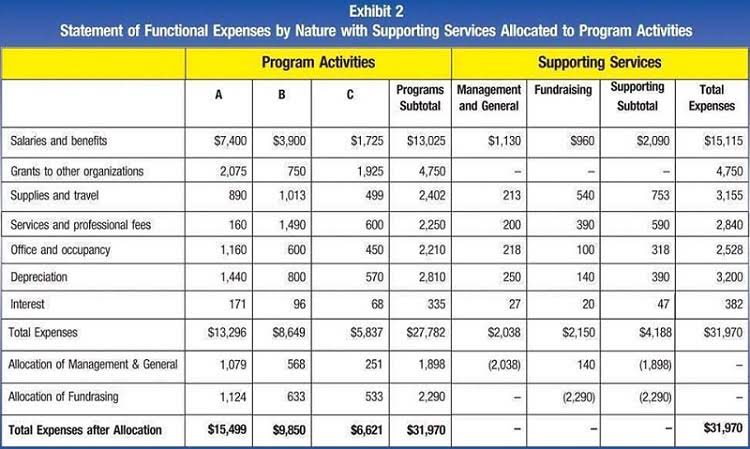As previously mentioned, the predetermined overhead rate is a way of estimating the costs that will be incurred throughout the manufacturing process. That means it represents an estimate of the costs of producing a product or carrying out a job. The estimate will be made at the beginning of an accounting period, before any work has actually taken place. The overhead cost per unit from Figure 6.4 is combined with the direct material and direct labor costs as shown in Figure 6.3 to compute the total cost per unit as shown in Figure 6.5. There are concerns that the rate may not be accurate, as it is based on estimates rather than actual data.
Which activity is most important to you during retirement?
Despite the fact that it may become more complex, it is considered more accurate and helpful to have different predetermined overhead rates for each department, because the level of efficiency and precision increases. Once you have a handle on your estimated overhead costs, you can plug these numbers into the formula to calculate your predetermined overhead rate. For example, overhead costs may be applied at a set rate based on the number of machine hours or labor hours required for the product. Recall that the standard cost of a product includes not only materials and labor but also variable and fixed overhead.
Get Your Questions Answered and Book a Free Call if Necessary
You will learn in Determine and Disposed of Underapplied or Overapplied Overhead how to adjust for the difference between the allocated amount and the actual amount. Since overhead costs cannot be easily traced to individual products like direct material or labor costs, overhead rates help to allocate a fair share of these costs based on the activity of making the product. This allows businesses to capture the full cost of production in their accounting. Figure 4.18 shows the monthly manufacturing actual overhead recorded by Dinosaur Vinyl. As explained previously, the overhead is allocated to the individual jobs at the predetermined overhead rate of $2.50 per direct labor dollar when the jobs are complete.
Limitations of the POHR formula
- A job cost sheet is a subsidiary ledger that identifies the individual costs for each job.
- Based on the above information, we must calculate the predetermined overhead rate for both companies to determine which company has more chance of winning the auction.
- In more complicated cases, a combination of several cost drivers may be used to approximate overhead costs.
- We follow strict ethical journalism practices, which includes presenting unbiased information and citing reliable, attributed resources.
- It can help manufacturers know when to review their spending more closely, in order to protect their business’s profit margins.
Departmental overhead rates are needed because different processes are involved in production that take place in different departments. The estimate is made at the beginning of an accounting period, before the commencement of any projects or specific jobs for which the rate is needed. Knowing the overhead cost per unit allows the business to set competitive pricing while still covering their indirect expenses. The key is choosing an appropriate cost driver – like machine hours in manufacturing or headcount in sales – to distribute overhead expenses.

Determining the Predetermined Overhead Rate Formula
For instance, imagine that your company has a new job coming up, and you need to calculate predetermined overhead rate for an estimate of manufacturing costs. The allocation of overhead to the cost of the product is also recognized in a systematic and rational manner. The overhead is then applied to the cost of the product from the manufacturing overhead account. The overhead used in the allocation is an estimate due to the timing considerations already discussed. If Department B has overhead costs of $30,000 but direct costs of $70,000, then its overhead rate is 43%.

Why You Can Trust Finance Strategists

Since the numerator and denominator of the POHR formula are comprised of estimates, there is a possibility that the result will not be close to the actual overhead rate. The fact is production has not taken place and is completely based on previous accounting records or forecasts. The example shown above is known as the single predetermined overhead rate or plant-wide overhead rate.
For example, the total direct labor hours estimated for the solo product is 350,000 direct labor hours. With $2.00 of overhead per direct hour, the Solo product is estimated to have $700,000 of overhead applied. When the $700,000 of overhead applied is divided by the estimated production of 140,000 units of the https://www.bookstime.com/articles/what-is-book-balance Solo product, the estimated overhead per product for the Solo product is $5.00 per unit. The computation of the overhead cost per unit for all of the products is shown in Figure 6.4. The overhead rate is calculated by dividing total overhead costs by an appropriate allocation measure such as direct labor hours.
- The overhead rate is calculated by dividing total overhead costs by an appropriate allocation measure such as direct labor hours.
- Also, it’s important to compare the overhead rate to companies within the same industry.
- This means that since the project would involve more overheads, the company with the lower overhead rate shall be awarded the auction winner.
- To avoid such fluctuations, actual overhead rates could be computed on an annual or less-frequent basis.
- The standard overhead rate is the total budgeted overhead of $10,000 divided by the level of activity (direct labor hours) of 2,000 hours.
4: Compute a Predetermined Overhead Rate and Apply Overhead to Production
- Nonetheless, ignoring overhead costs, like utilities, rent, and administrative expenses that indirectly contribute to the production process of these gadgets, would result in underestimating the cost of each gadget.
- However, the variable standard cost per unit is the same per unit for each level of production, but the total variable costs will change.
- For example, overhead costs may be applied at a set rate based on the number of machine hours or labor hours required for the product.
- To summarize the job order cost system, the cost of each job includes direct materials, direct labor, and manufacturing overhead.
Sales of each product have been strong, and the total gross profit for each product is shown in Figure 6.7. Using the Solo product as an example, 150,000 units are sold at a price of $20 per unit resulting in sales of $3,000,000. The cost of goods sold consists of direct materials of $3.50 per unit, direct labor of $10 per unit, and manufacturing overhead of $5.00 per unit. With 150,000 units, the direct material cost is $525,000; the direct labor compute predetermined overhead rate cost is $1,500,000; and the manufacturing overhead applied is $750,000 for a total Cost of Goods Sold of $2,775,000. If the predetermined overhead rate calculated is nowhere close to being accurate, the decisions based on this rate will definitely be inaccurate, too. That is, if the predetermined overhead rate turns out to be inaccurate and the sales and production decisions are made based on this rate, then the decisions will be faulty.
- By having multiple rates like this, you can achieve a greater degree of accuracy.
- Two companies, ABC company, and XYZ company are competing to get a massive order that will make them much recognized in the market.
- With $2.00 of overhead per direct hour, the Solo product is estimated to have $700,000 of overhead applied.
- Each of the four will be at beginning stages at either the beginning of the current month or the end of the current month.
- The predetermined overhead rate allocates estimated total overhead for an accounting period across expected activity or production volume.
- Take self-paced courses to master the fundamentals of finance and connect with like-minded individuals.
Why are predetermined overhead rates important?
The predetermined overhead rate formula can be used to balance expenses with production costs and sales. For businesses in manufacturing, establishing and monitoring an overhead rate can help keep expenses proportional to production volumes and sales. It can help manufacturers know when to review their spending more closely, in order to protect their business’s profit margins.


